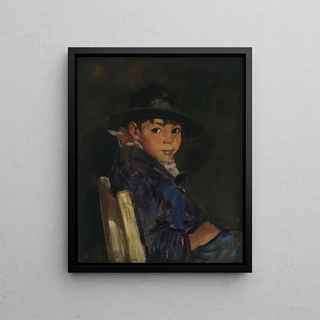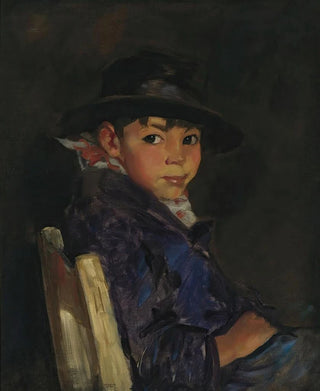Art print | Young Athlete Francisco - Robert Henri


View from behind

Frame (optional)
In the vibrant world of early 20th-century American art, "Young Athlete Francisco" by Robert Henri stands as an iconic work, capturing with finesse the essence of youth and energy. This canvas, painted in 1910, depicts a young man in a dynamic pose, symbolizing both the vitality of youth and the spirit of the era. Henri, a central figure of the Ashcan School movement, mastered immersing himself in the realities of his time, and this piece is a perfect reflection of that. The scene, both intimate and universal, invites us to delve into the soul of its subject, revealing deep emotions and an authentic connection with the viewer.
Style and uniqueness of the work
Robert Henri's style is characterized by a bold approach and a keen sense of observation. In "Young Athlete Francisco," he employs vigorous brushstrokes and a palette of vibrant colors to breathe palpable life into his subject. Light plays a central role, accentuating the features of the young man while creating a warm and engaging atmosphere. Henri does not merely reproduce an image; he captures an essence, an attitude, a way of being. This painting, through its realistic treatment and dynamic composition, stands out from the academic conventions of the time, offering a refreshing and modern vision of the human figure. The posture of the young athlete, both relaxed and ready for action, evokes a sense of freedom and optimism, characteristic of a generation in full effervescence.
The artist and his influence
Robert Henri, born in 1865, was a pioneer in the emergence of art that reflects contemporary life. As a leader of the Ashcan School movement, he sought to portray the everyday reality of the working classes, moving away from the romantic ideals that predominated in his era. His influence extends far beyond his own works, inspiring numerous artists to embrace spontaneity and authenticity in their practice. Henri always encouraged his students to observe the world around them with a critical and empathetic eye, a philosophy that continues to resonate in the art world.

Matte finish

View from behind

Frame (optional)
In the vibrant world of early 20th-century American art, "Young Athlete Francisco" by Robert Henri stands as an iconic work, capturing with finesse the essence of youth and energy. This canvas, painted in 1910, depicts a young man in a dynamic pose, symbolizing both the vitality of youth and the spirit of the era. Henri, a central figure of the Ashcan School movement, mastered immersing himself in the realities of his time, and this piece is a perfect reflection of that. The scene, both intimate and universal, invites us to delve into the soul of its subject, revealing deep emotions and an authentic connection with the viewer.
Style and uniqueness of the work
Robert Henri's style is characterized by a bold approach and a keen sense of observation. In "Young Athlete Francisco," he employs vigorous brushstrokes and a palette of vibrant colors to breathe palpable life into his subject. Light plays a central role, accentuating the features of the young man while creating a warm and engaging atmosphere. Henri does not merely reproduce an image; he captures an essence, an attitude, a way of being. This painting, through its realistic treatment and dynamic composition, stands out from the academic conventions of the time, offering a refreshing and modern vision of the human figure. The posture of the young athlete, both relaxed and ready for action, evokes a sense of freedom and optimism, characteristic of a generation in full effervescence.
The artist and his influence
Robert Henri, born in 1865, was a pioneer in the emergence of art that reflects contemporary life. As a leader of the Ashcan School movement, he sought to portray the everyday reality of the working classes, moving away from the romantic ideals that predominated in his era. His influence extends far beyond his own works, inspiring numerous artists to embrace spontaneity and authenticity in their practice. Henri always encouraged his students to observe the world around them with a critical and empathetic eye, a philosophy that continues to resonate in the art world.






